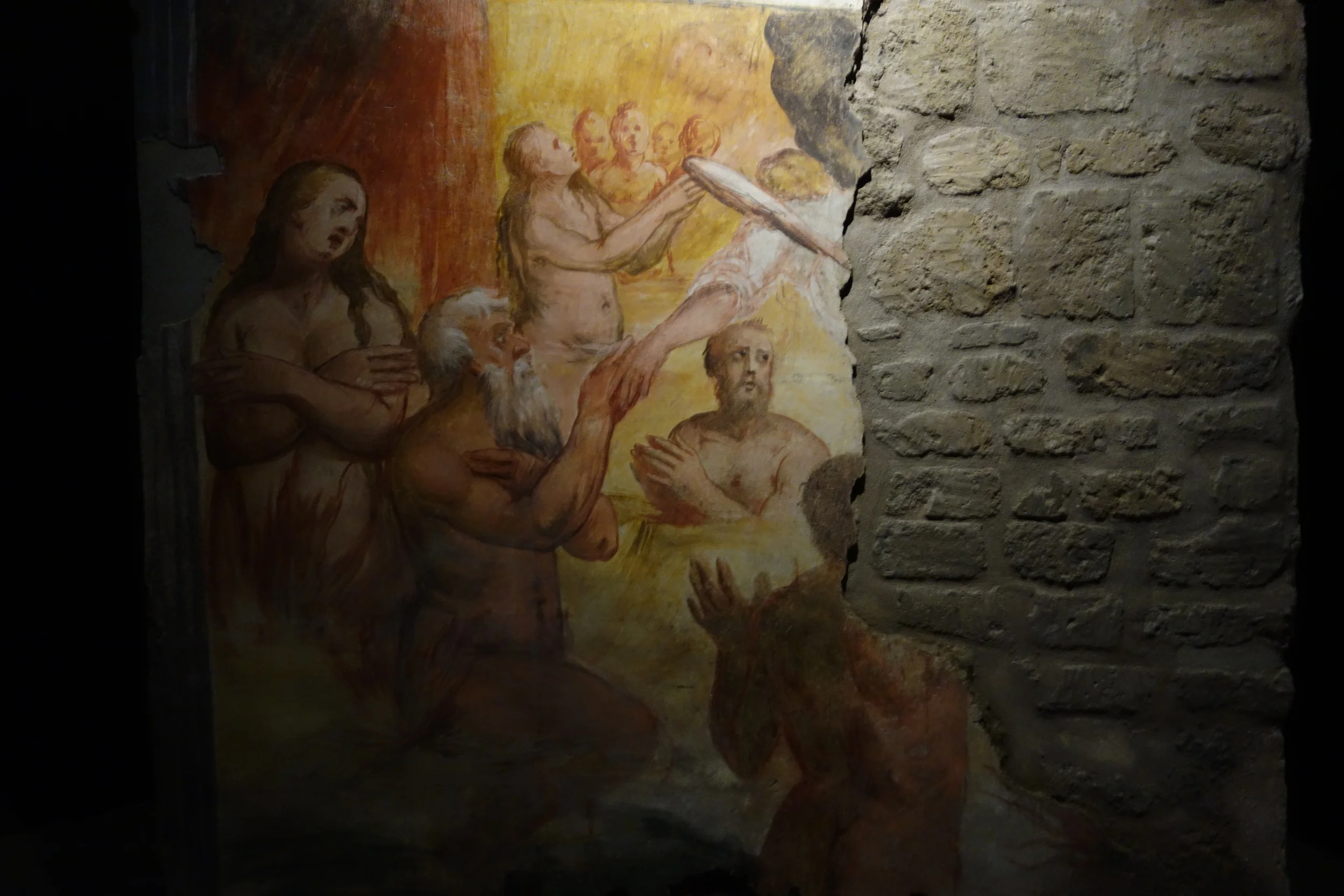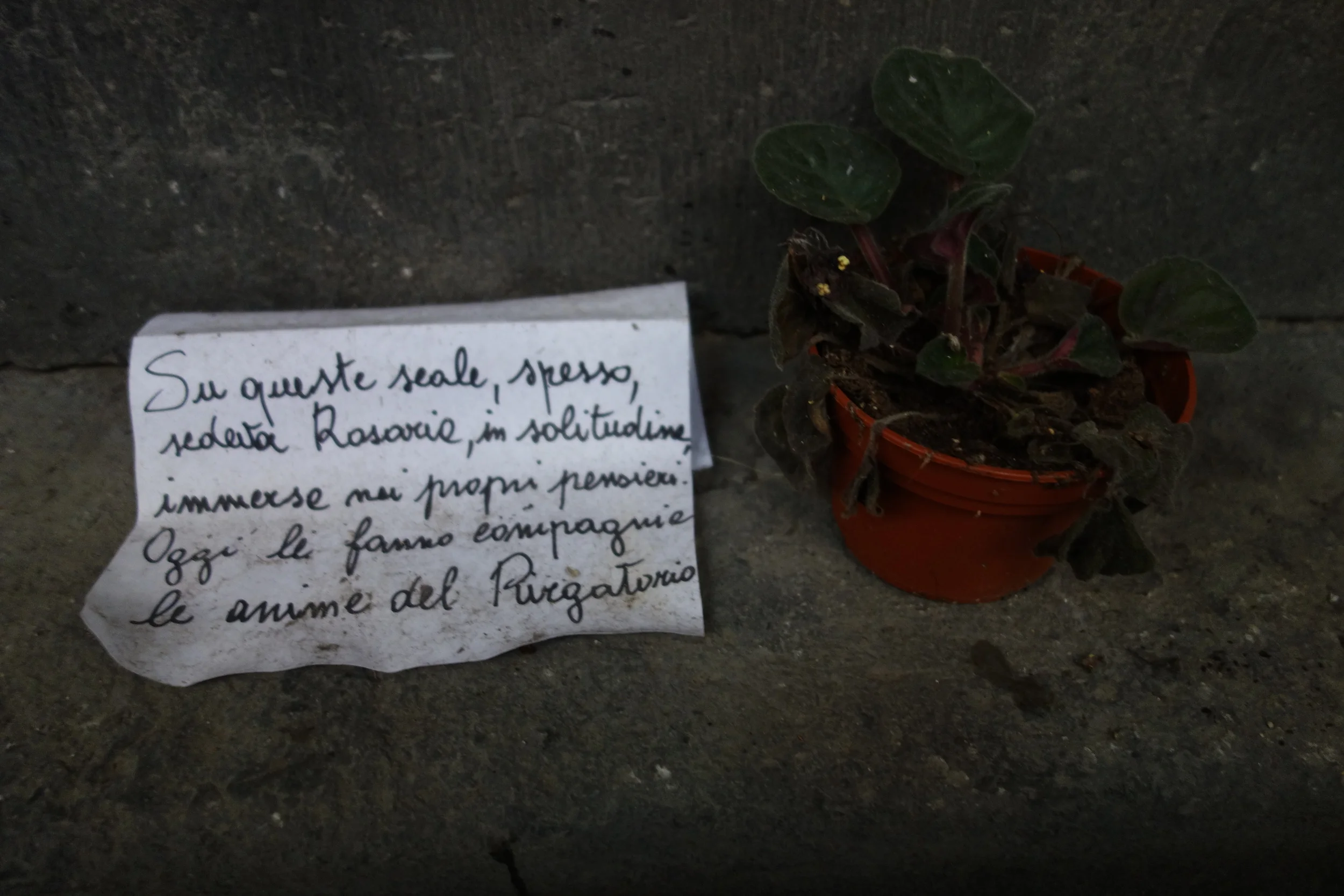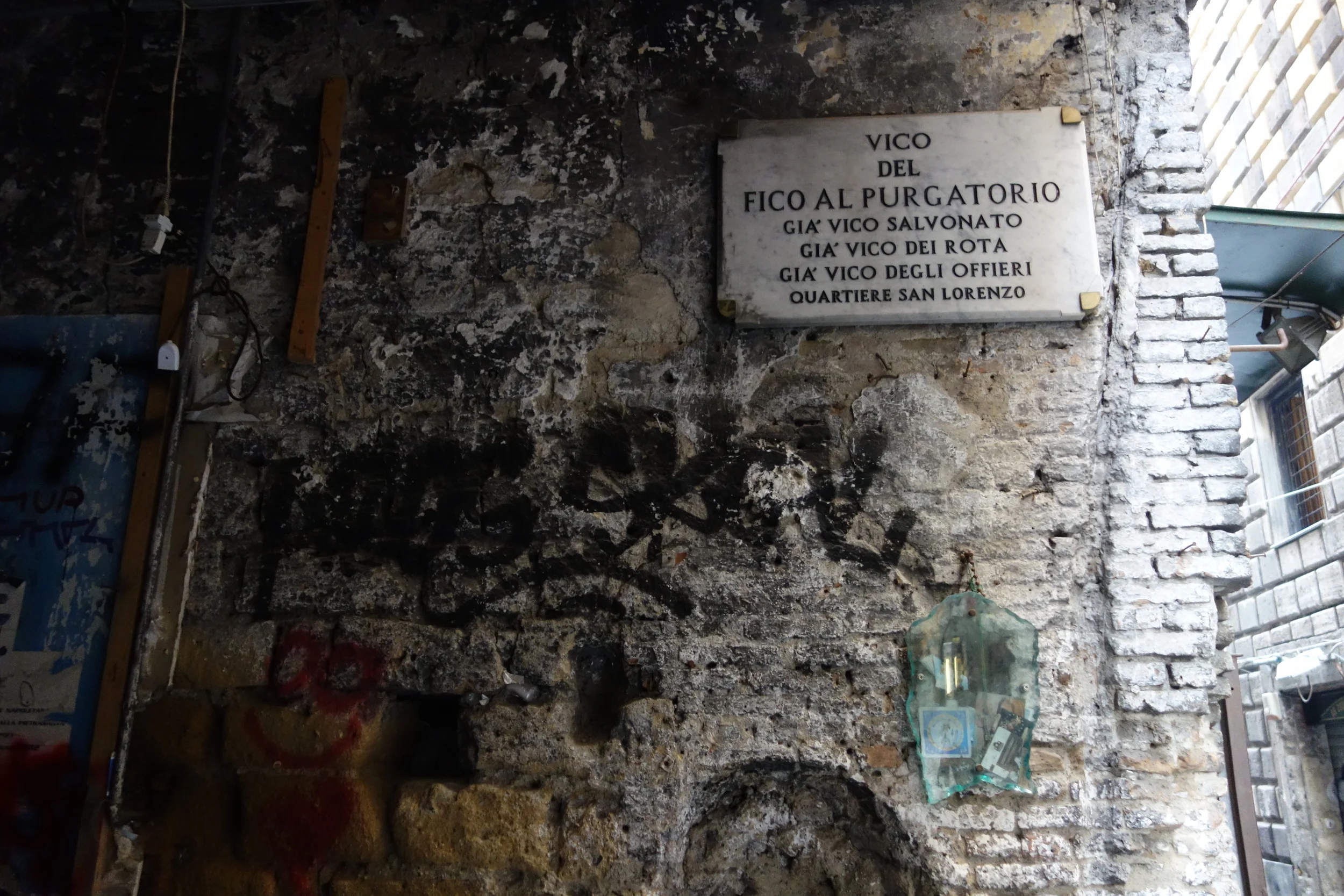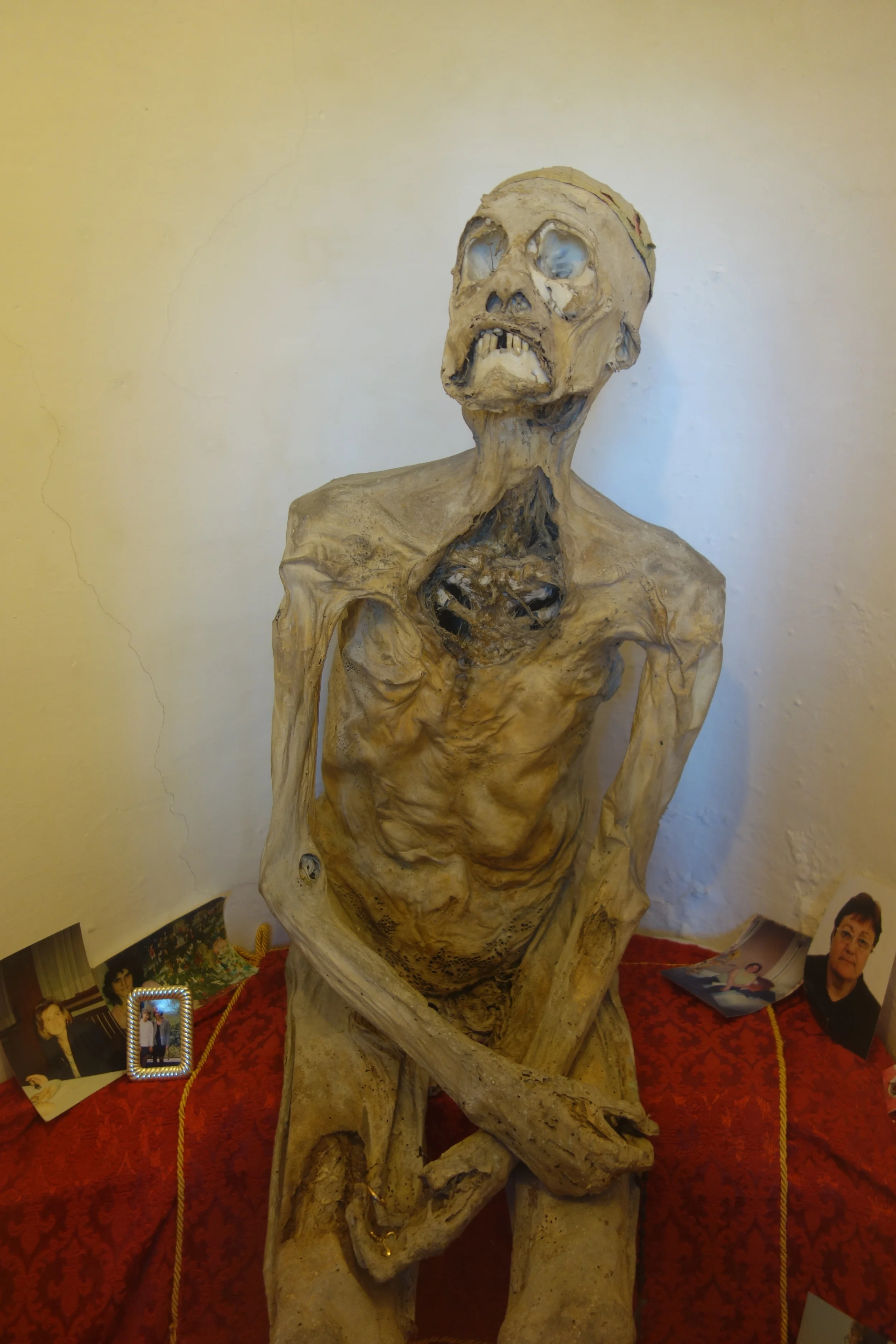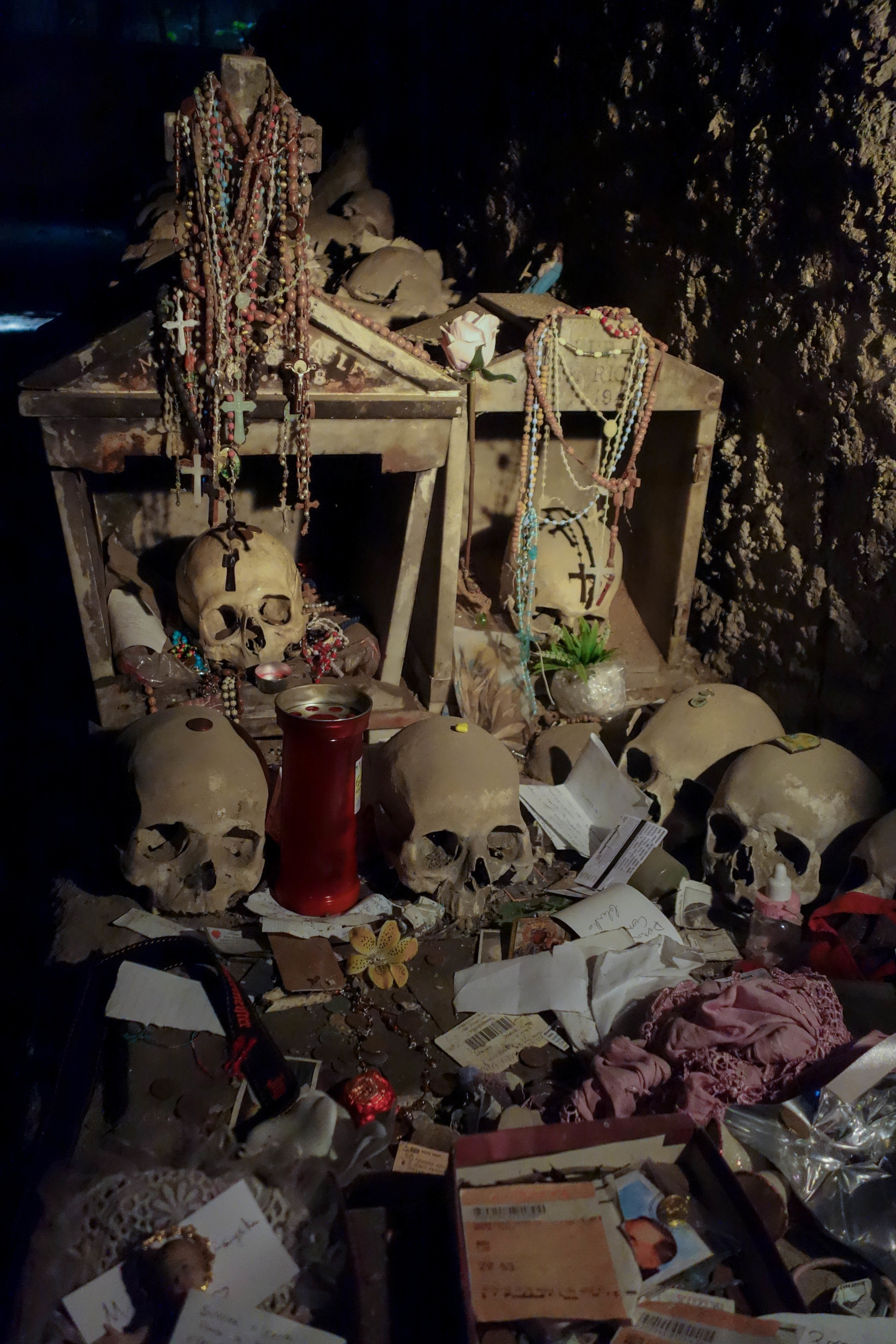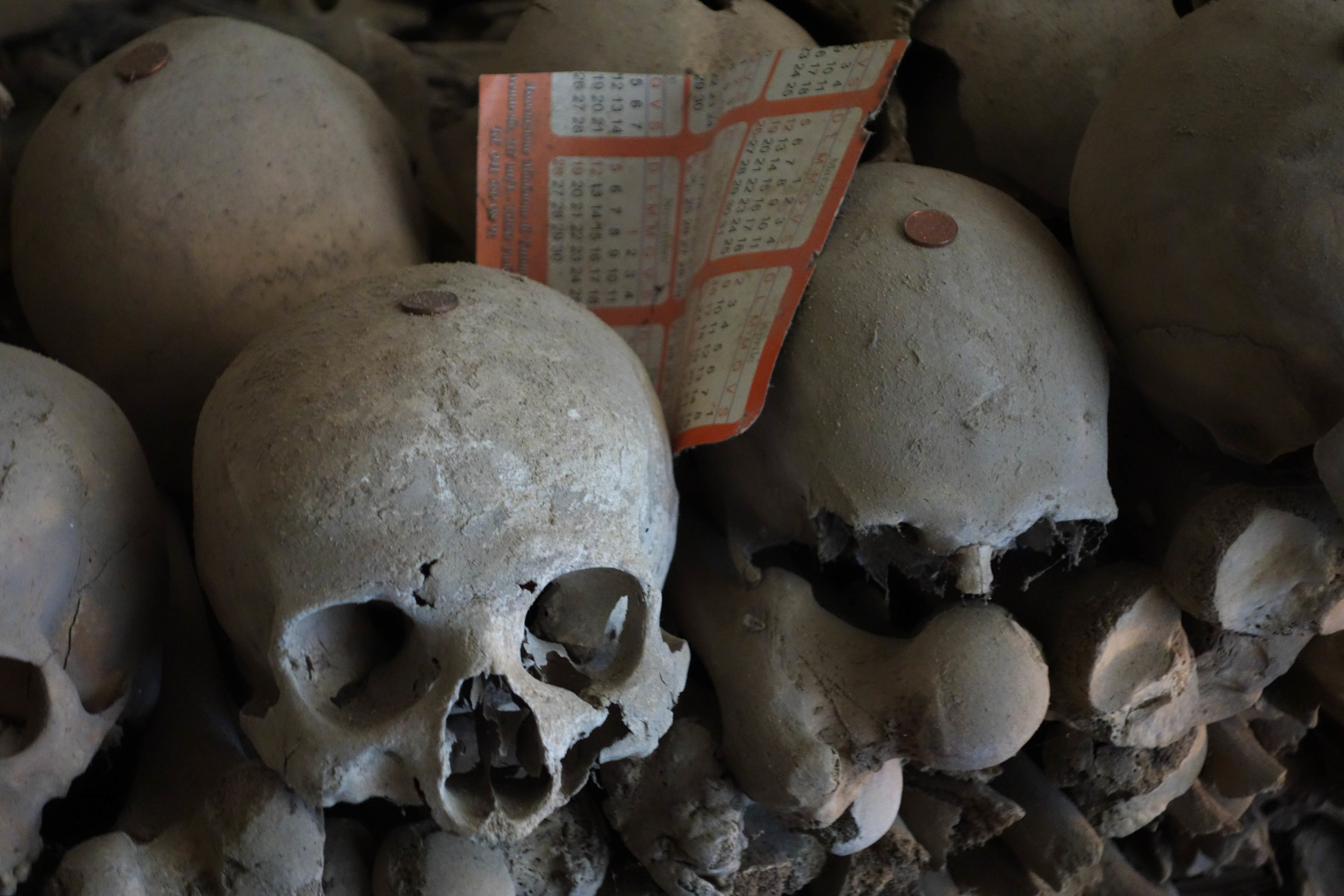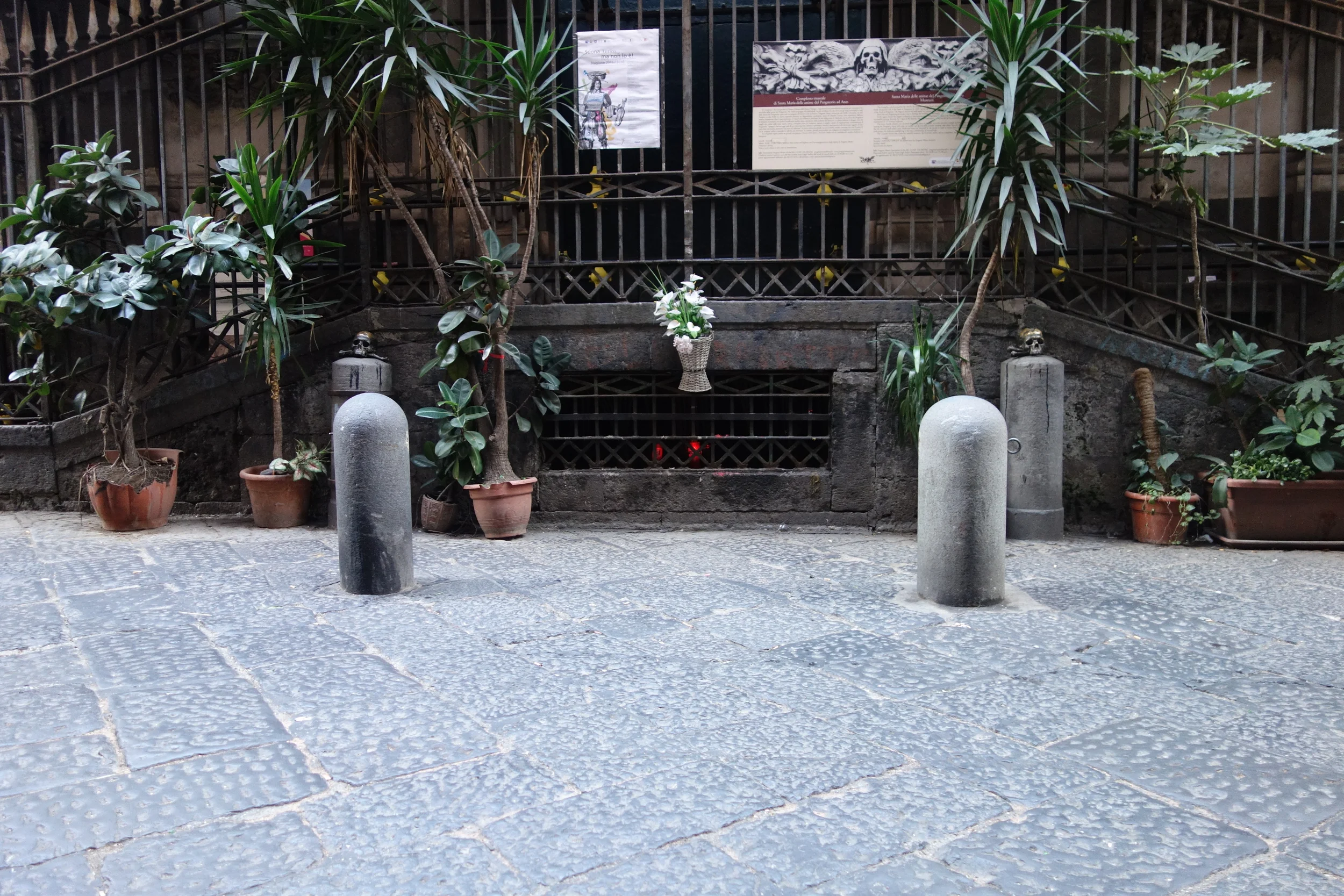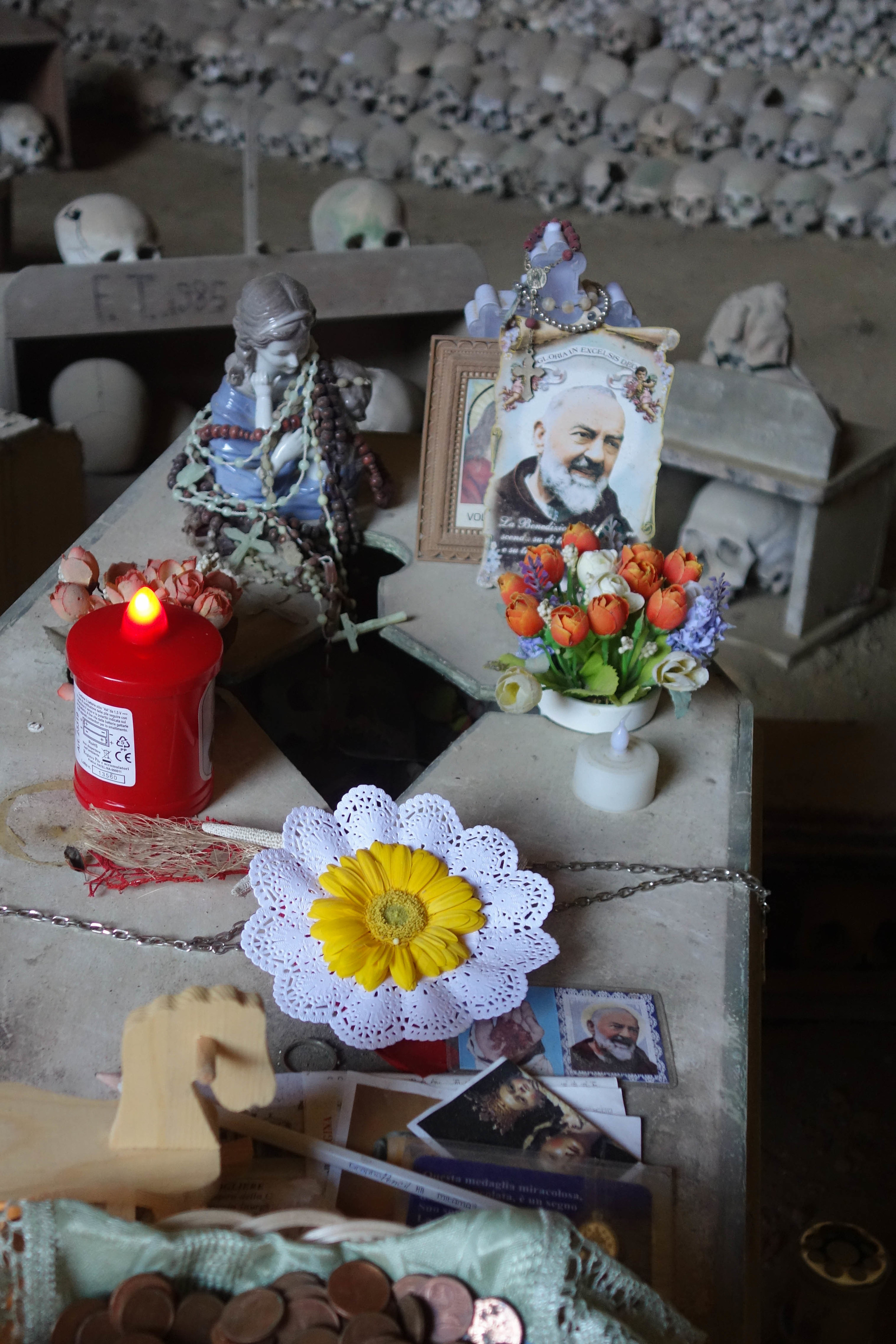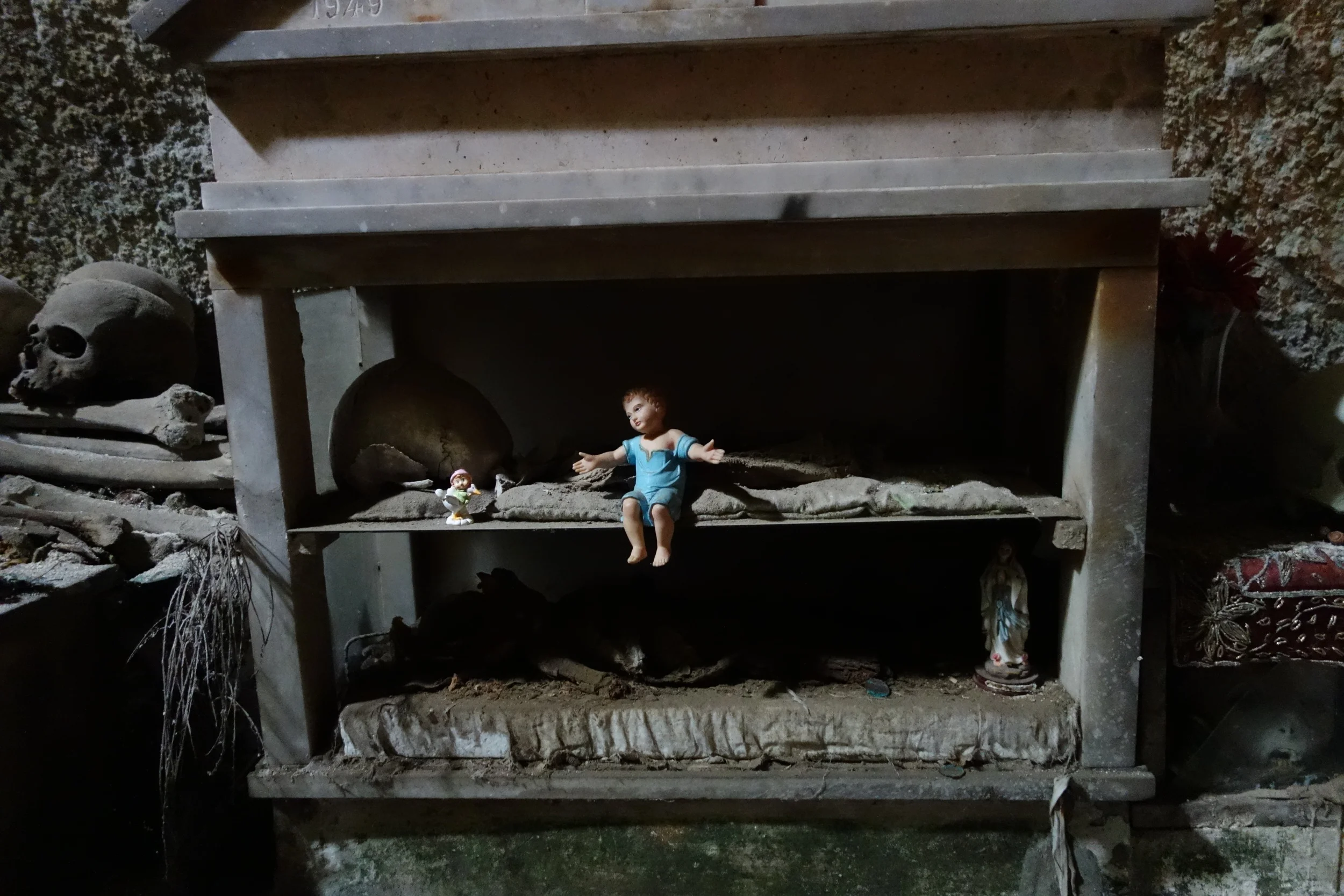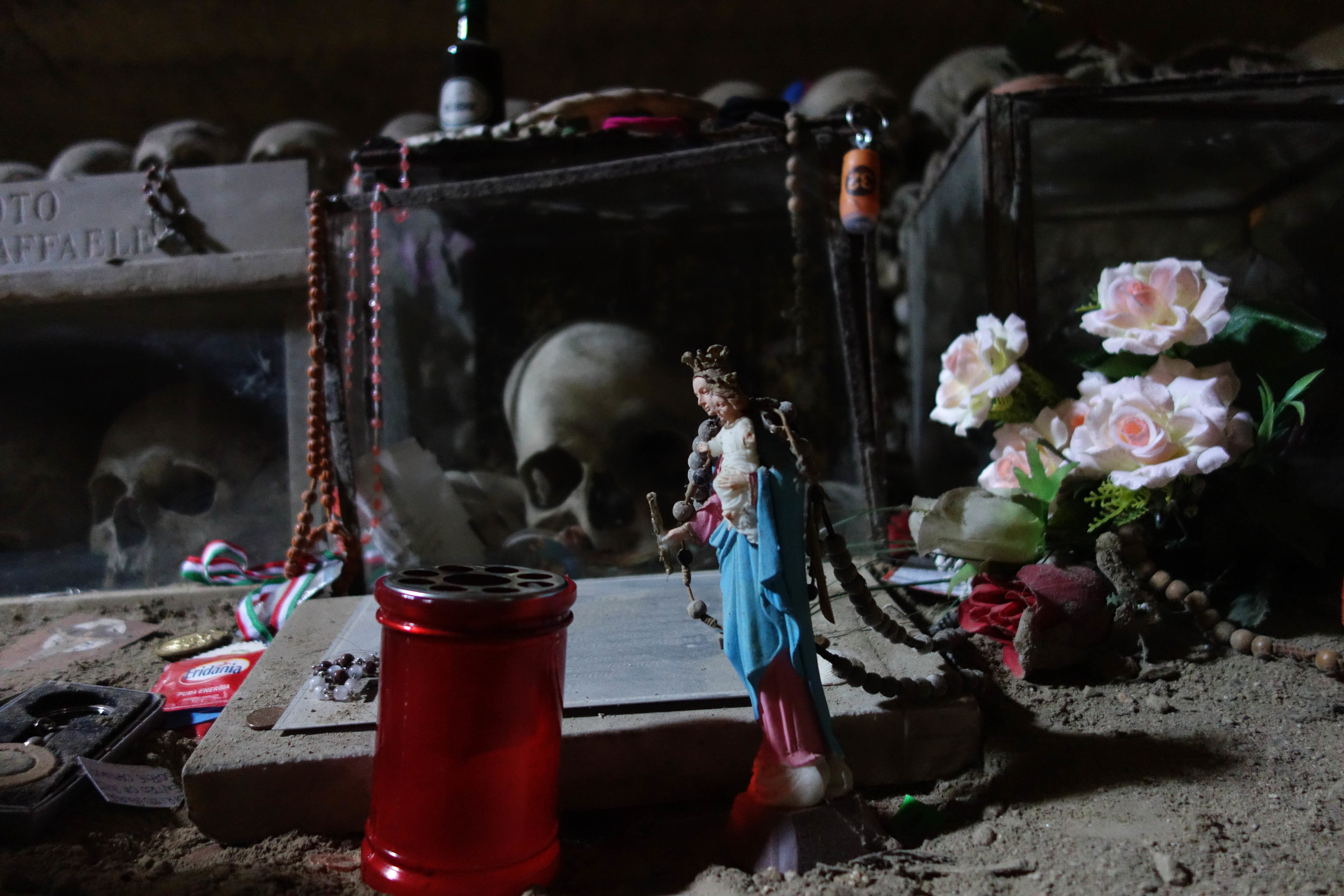The Neapolitan Cult of the Dead: A Profile for Virginia Commonwealth University
This profile was published as an entry in Virginia Commonwealth University's World Religions and Spirituality Project.
CULT OF THE DEAD TIMELINE
1274: Purgatory was formally accepted as Catholic doctrine and defined by the Church as “the place of purification through which souls pass on their way to paradise” at the second Council of Lyons.
1438-1443: The Council of Florence added that “the suffrages of the faithful still living were efficacious in bringing [souls in purgatory] relief from such punishment…”
1563: An additional decree concerning purgatory was passed at the Council of Trent, delineating Church-sanctioned ideas about purgatory from “those things that tend to a certain kind of curiosity or superstition, or that savor of filthy lucre”.
1476: Pope Sixtus IV confirmed that indulgences might be earned by the living for souls in purgatory, thus shortening individual souls' time there.
1616: A group of Neapolitan noblemen founded the Congrega di Purgatorio ad Arco, a group dedicated to burying the poor and praying for their souls in purgatory.
1620s: St. Robert Bellarmine taught that souls in purgatory could help the living because they are closer to God than people on Earth; however souls in purgatory cannot hear specific prayer requests.
1638: The church of Santa Maria delle Anime del Purgatorio ad Arco was completed and consecrated. Below the church was a hypogeum which is used by the Congrega di Purgatorio ad Arco for burying the city's poor.
1656-1658: The Black Death, or Bubonic plague (Yersinia pestis), devastated Naples, killing roughly half of the city's inhabitants. Of the estimated 150,000 dead, many were hastily buried in pits or existing tufa caves without markers.
1780s: Neapolitan priest, St. Alphonsus Maria de' Liguori of Naples, built on St. Robert Bellarmine's teaching on purgatory. Liguori taught that God makes the prayers of the living known to souls in purgatory, which made it possible for the dead to help the living with specific matters on Earth.
1837: Victims of a cholera epidemic in Naples were buried in the mass graves around the city, including the Fontanelle cemetery.
1872: Father Gaetano Barbati sorted and catalogued the bones in the Fontanelle Cemetery with volunteers from the city, who prayed for the dead while they completed the work.
1940-1944: A number of the tufa caves used as burial grounds served as bomb shelters during World War II, giving new reason for the living to pray to the souls in purgatory, who were represented by the bones buried there.
1969: Archbishop of Naples, Corrado Ursi decreed that “expressions of cult addressed to human remains” were“ arbitrary, superstitious, and therefore inadmissible.”
1969: The Fontanelle cemetery was closed, and the Cult of the Dead was suppressed.
1980: The Irpinia earthquake struck Naples, closing the church of Santa Maria delle Anime del Purgatorio ad Arco, effectively suppressing remaining activities of the Cult of the Dead.
1980s (Late): I Care Fontanelle was formed to give tours and counteract “degradation” to the Fontanelle cemetery, both the structure of the cave itself and the lingering activities of the Cult of the Dead.
1992: The church of Santa Maria delle Anime del Purgatorio ad Arco was reopened after restoration work was completed.
2000-2004: More restoration work at Fontanelle Cemetery took place.
2006: The Fontenelle Cemetery was reopened on a limited basis.
2010: The Fontenelle Cemetery was reopened full time.
FOUNDER/GROUP HISTORY
To its adherents, the Neapolitan Cult of the Dead exists as a part of the Catholic faith. In fact, adherents often do not identify their religious beliefs as anything other than Catholic or use the designation “Cult of the Dead.” However to the Catholic Church, the cult is heretical and exists outside of the faith. The core beliefs of the cult can best be understood as a mixture of Catholic doctrine concerning purgatory and pre-existing folk-religion within the former Kingdom of Naples (now Southern Italy). In this regional folk-religion, the living attempt to build personal relationships with the souls of the dead. They view these relationships as a practical way to obtain miracles and improve everyday life.
To understand how the Cult of the Dead departs from Catholic interactions with the souls of the dead, one must first understand the concept and origin of purgatory.
As Jaques Le Goff outlined in his seminal book, The Birth of Purgatory, in the twelfth and thirteenth centuries, the concept of the afterlife became increasingly specific due to a number of cultural shifts. One particularly important shift was the evolution of the concept of justice; punishments for crimes began to be tailored to individual circumstances. This concept eventually extended into the afterlife and a person's fate after death reflected the magnitude of his or her sins. This was accomplished through the conception of a third place, other than heaven and hell. It was a temporary place for punishment and atonement thought to be adjacent to hell. All souls marred by sin were believed to go there for a time that corresponded to the number and severity of an individual's sins before being admitted into heaven. The place was called “purgatory” and the concept was formally accepted as doctrine in 1274 at the second Council of Lyons.
By the fifteenth century, Catholic doctrine allowed the living to earn indulgences for the suffering souls in purgatory as they had previously earned indulgences for themselves. (An indulgence is a remission or reduction of temporal punishment for sin, earned through spiritual exercises and acts of charity.) This effectively extended the power of the pope (who granted these indulgences) from the earthly realm into the afterlife for the first time. For this reason, the concept of indulgences for the dead was quickly embraced by elite clergy members eager to expand papal power. However the laity embraced this new form of charity for the dead for entirely different reasons.
Throughout the Kingdom of Naples, popular Catholicism already operated in an unorthodox way, through a tit-for-tat system of prayers said in exchange for divine favors granted. This folk Catholicism appeared orthodox to the clergy but was heterodox in practice. It was an individualistic, results-based style of worship that coexisted with belief in folk-magic and witchcraft, especially among the lower classes. Specific icons of the Madonna, as well as the relics of saints appeared to be venerated by the laity in the orthodox way (by praying with the icon or relic, not to it) but these prayers were, in practice, said to the icon or saint. In turn these images and objects were expected to use their supernatural powers to aid the venerator. When prayers were answered, the person who made the request would bring a token of gratitude, called an ex voto, to the shrine where the request was made [Image at right]. In orthodox Catholicism, ex votos are offered freely in thanksgiving; however, in Neapolitan folk Catholicism, these gifts establish a unique, reciprocal relationship between the individual and the tangible sacred object (the icon or relic). From this moment of reciprocity on, the relationship was expected to be mutually beneficial and could be reversed at any time should the sacred object fail to perform or the venerator fail to express appropriate gratitude.
When the Catholic Church eventually permitted prayers to be said on behalf of souls in purgatory, these reciprocal relationships, formerly limited to saints and the Virgin Mary, expanded to include the dead even though the Church remained adamant that souls in purgatory had no supernatural powers. This dissenting belief, that the souls of ordinary dead people had the power to help the living, formed the basis of the Cult of the Dead in the Kingdom of Naples. Prominent Catholic theologians and clergy such as St. Robert Bellarmine and St. Alphonsus Maria de' Liguori attempted to expand the orthodox relationship with souls in purgatory to include addressing prayers directly to them. The hope was to include the heretical Neapolitans instead of ostracizing the faithful in a region that had historically been a stronghold for the papacy. However these measures failed to fully bring the Neapolitan concept of purgatory into orthodoxy since the logic of purgatory with its approved system of indulgences neatly meshed with the existing logic of folk Catholicism.
The impact of the Cult of the Dead on Catholicism in Italy has waxed and waned but its presence has often been most noticeable during times of strife: specifically among women affected by disease, natural disaster, or war who lack access to power and resources within the Catholic Church. Though the Cult of the Dead is present throughout the former Kingdom of Naples which encompasses much of Southern Italy today, it took a strong hold in the city of Naples due to its unique history of large-scale disasters. This is primarily where the presence of the cult can still be felt today.
DOCTRINES/BELIEFS
While praying for souls in purgatory exists within the Catholic Church, there are two main differences that separate the beliefs of the Cult of the Dead from those of the Church. The first is the reciprocal relationship between the dead and the living. Catholic doctrine does not allow the souls in purgatory the power to bestow favors on the living, nor does it believe they ought to be venerated as one would venerate saints or the Virgin Mary. For orthodox Catholics, the relationship between the living and souls in purgatory is strictly one-sided and charitable: prayers said by the living are intended to shorten the dead's time in purgatory without the expectation of reward. In contrast, members of the Cult of the Dead expect the souls in purgatory to hear their prayers and affect change quickly in their lives. This added benefit explains the unique preoccupation with purgatory in Naples, from the unusually high number of confraternities devoted to caring and praying for the dead, such as the Arciconfraternita dei Bianchi and the Congrega di Purgatorio ad Arco, to the Neapolitan practice of building shrines to souls in purgatory in niches on the street, [Image at right] often complete with terra cotta figurines of people standing in flames and photos of deceased family members.
The second difference is in the distinction that the Cult of the Dead makes between the known and unknown dead. In the Catholic Church, prayers said for souls in purgatory can be specific for a person or for the souls in purgatory in general. Either is considered a charitable way to shorten time in purgatory for the intended. However the Cult of the Dead divides souls into two categories: the known dead and the unknown dead. These two groups are venerated differently and are believed to have two very different fates.
The known souls are addressed in prayer by name. Prayers said to them are thought to shorten their time in purgatory, but when it comes to the reciprocal relationship, these souls are thought to be less powerful and less likely to grant miracles to their living benefactor.
The unknown souls are more important to the Cult of the Dead, and here the cult departs dramatically from Catholic doctrine. The cult believes that souls whose names remain unknown, typically people who died in plagues, wars, or natural disasters, are doomed to an eternity in purgatory. These souls are represented by the anonymous bones in Naples' numerous mass graves and burial caves which have been entombed without markers. Within the Cult of the Dead, these souls are collectively venerated and are thought to be extremely powerful when it comes to bestowing miracles on the living. For this reason, the dead are often commemorated collectively, through the stacking and cataloguing of their bones (as in the case of the Fontanelle Cemetery), building churches above the places they were buried (as in the cases of Santa Maria del Pianto and Santa Croce e Purgatorio al Mercato which replaced the original plague column memorial), or in the preservation of anonymous bodies within the church (as are on display at the Chiesa del Santissimo Crocifisso detta la Sciabica).
Within the cult, the relationship between living and anonymous dead must still remain reciprocal. But without the possibility of releasing a soul from purgatory, the living pray for refrisco for the unknown souls. Refrisco is thought to be a temporary relief from the fires of purgatory, like a cool drink on a hot day. This concept was illustrated in the image of the Madonna of Graces, a popular image of the Virgin Mary expelling breast milk into purgatory. Though some examples still exist, this image was successfully diminished by the Church during the Counter-Reformation due to its sensuality and association with popular but heretical views on purgatory.
RITUALS/PRACTICES
As in its beliefs, in its practices, the Cult of the Dead shares some overlap with Catholicism. These co-practices include having masses said for the dead and earning indulgences for the souls in purgatory through prayers and penance (although the concept of earning refrisco for unknown souls is strictly part of the folk view of purgatory that the Cult of the Dead embraces, rather than official Catholic doctrine).
The primary ritual associated with the Cult of the Dead that does not exist in within the Catholic Church is the adoption and veneration of anonymous human remains. This can take several forms. In the broadest sense, an entire town may adopt a mass grave site such as a prisoner's cemetery, plague pit or potter's field and erect a monument where people can come to pray to the souls and leave ex votos. In other instances, specific anonymous remains are adopted by a community and elevated to folk-saint status, as in the case of a mummy nicknamed “Uncle Vincent” in the town of Bonito.
However, this practice of adoption and veneration is most closely associated with the city of Naples and its burial caves and hypogea. This is where members of the Cult of the Dead come to adopt skulls called “pezzentelle,” which means “poor little ones” in Neapolitan dialect. Though considered heretical by the Church, this practice of petitioning a found skull can be understood as a logical outgrowth of the Catholic practice of veneration of saints' relics.
Indeed, the more famous skulls in Naples such as “Lucia the Virgin Bride” (who rests in the hypogeum at Santa Maria del Purgatorio ad Arco), “Donna Concetta,” and the “The Captain” (both at the Fontanelle Cemetery) are treated like the relics of saints, in that they are considered community property and cannot be adopted by an individual. They receive prayers and thanks from many people and collect ex votos, for prayers answered, just as saints do at the shrines where their relics rest.
While these famous skulls attract the attention of devotees and tourists alike, private skull veneration is more typical within the Cult of the Dead in Naples. While not unheard of in orthodox Catholicism, private relic veneration has been frequently discouraged, fearing it would lead to idolatry or fetishism, and nearly always occurred in the context of a wealthy individual keeping the relic of a saint at home. In contrast, private relic veneration within the Cult of the Dead still happens in public, usually at an ossuary like the Fontanelle cemetery or one of the small hypogea that are still scattered around Naples, such as the one at Santa Maria delle Anime al Purgatorio ad Arco.
The process begins with the adoption. In some cases the skull is chosen by the faithful who dedicates prayers to it, lights candles,or may place a coin on it. In other cases, the person is adopted by a particular skull who comes to the living in a dream to ask for veneration. Communications between the living and the dead typically occur through dreams and the unnamed soul will often reveal its name to the living in this way.
In successful adoptions, the skull and its corresponding soul in purgatory enter into a reciprocal relationship with the living venerator. The living provides prayers and refrisco for the soul in purgatory, and the soul responds by seeing that the person's prayers are answered. Adopted skulls are often said to cure infertility or other health problems, provide winning lottery numbers, or solve domestic problems. When the living receive answers to their prayers, they reward the skull with ex votos such as rosaries, flowers, or little shelters typically made of marble, glass, Plexiglas, or wood. These are meant not only protect the skull, but also to send the message to other favor-seekers that this skull is not available for adoption. Skulls that do not answer prayers can be stripped of their gifts and sometimes re-abandoned in favor of a skull with a more generous soul. (Though this vengeful behavior isn't limited to the Cult of the Dead in Naples, the bust of the city's most famous patron saint, San Gennaro, was thrown into the sea in 1799 for traitorously granting the wishes of an occupying French general.)
Neapolitan followers of the Cult of the Dead are often thought to come with gifts for their skulls on Mondays, particularly at the Fontanelle cemetery. While this may have been true in the past when the cult was more active, contemporary evidence of the Cult of the Dead appears to show up sporadically.
LEADERSHIP/ORGANIZATION
While there are Church officials who have certainly advanced the orthodox concept of purgatory particularly in Naples, such as St. Alphonsus Maria de' Liguori (who first theorized that God could make the specific prayer requests of the living known to the dead) and Fr. Gaetano Barbati, there is no leadership or organization specifically for the Cult of the Dead. The traditions are passed down and often turned to during times of particular strife and hardship.
Though high-ranking members of the Catholic Church have engaged with and addressed the Neapolitan Cult of the Dead, the cult itself has never had a formal structure, head, or even representative. It is simply a group of laity who often view the existing institutional structure of the Church as their own, although their practices pertaining to the cult remain at odds.
ISSUES/CHALLENGES
Today the Cult of the Dead is only slightly active and particularly within Naples, evidence of it is often downplayed or blamed ontourists by locals with more orthodox views. While several of the mass grave sites and confraternity burial grounds have been closed to the public entirely, sites such as the catacombs of San Gennaro and church of Santa Maria delle Anime del Purgatorio ad Arco are now primarily cultural institutions controlled by the Council of Naples. Visitors must pay an entrance fee and are restricted to guided tours to discourage participation in the cult. While this has virtually eliminated unwanted ex votos and bone theft from the catacombs and hypogea, one can still find persistent traces of the cult in the form of ex votos, letters and candles left near these sites, or in the case of Santa Maria delle Anime del Purgatorio ad Arco, near the grated window to the hypogeum on the street.
The main focus of cult activities today centers around the Fontanelle cemetery where there is no entry fee and tour guides are not currently mandatory. The community group, I Care Fontanelle, formed in the 1980s in an attempt to eliminate the theft and relocation of bones, as well as to discourage people from erecting new shrines and leaving devotional items that could damage the site. Over the years, the group has also addressed ongoing structural issues with the tufa cave (most recently a cave-in that closed the cemetery for several months in 2011 and water leaks that persist today). While I Care Fontanelle's leadership has successfully addressed these pressing issues, the ongoing lack of funds has left the lighting and video surveillance systems in disrepair. Without these safeguards, the Cult of the Dead still operates. Its adherents leave rosaries, prayer cards, candles, lottery tickets, coins, and even plastic dolls and religious figurines for specific skulls; and new housings for skulls still occasionally show up.
REFERENCES
Ariès, Philippe. 1981. The Hour of Our Death: The Classic History of Western Attitudes Toward Death Over the Last One Thousand Years. New York: Knopf.
Carroll, Michael P. 1996. Veiled Threats: The Logic of Popular Catholicism in Italy. Baltimore: Johns Hopkins University Press.
Cenzi, Ivan, and Carlo Vannini. 2015. Il Cimitero Delle Fontanelle Di Napoli: De Profundis. Translated by Sally McCorry. Modena: Logos Edizioni.
Ehlert, Rebecca Lisabeth. 2007. "S. Maria Del Pianto: Loss, Remembrance and Legacy in Seventeenth Century Naples." Thesis. Queen's University, Kingston, Ontario, Canada. Accessed from //Users/elizabethharper/Downloads/Ehlert_Rebecca_L_2000710_MA%20(1).pdf.
Goff, Jacques Le. 1984. The Birth of Purgatory. Chicago: University of Chicago Press.
Koudounaris, Paul. 2011. THE EMPIRE OF DEATH: A Cultural History of Ossuaries and Charnel Houses. New York: Thames & Hudson.
Leeden, Michael A. 2009. "Death in Naples." First Things, August. Accessed fromhttp://www.firstthings.com/article/2009/08/death-in-naples on 26 March 2016.
Maria, Lombardi Satriani Luigi, and Mariano Meligrana. 1982. Il Ponte Di San Giacomo. Milano: Rizzoli.
Stratton, Margaret. 2010. The Living and the Dead: The Neapolitan Cult of the Skull. Chicago: Center for American Places at Columbia College Chicago.
"Discovering the Mysteries of Naples." 2001. City of Naples, May 17. Edited by Giuseppe Contino. City of Naples. Accessed fromhttp://www.comune.napoli.it/flex/cm/pages/ServeBLOB.php/L/EN/IDPagina/5645 2001 on 26 Mar. 2016.
"I Care-fontanelle." 2015. I Care Fontanelle. N.p., n.d. Accessed from http://www.icare-fontanelle.it on 26 March 2016.
"Purgatorio Ad Arco." N.d. Purgatorio Ad Arco. Santa Maria Delle Anime Del Purgatorio Ad Arco. Accessed from http://www.purgatorioadarco.it/ on 26 March 2016.
IMAGES
Image #1: A fresco of souls in purgatory inside the Catacombe di Dan Gaudioso Naples, Italy.
Image #2: An offering of a plant and a note outside the Church of Santa Maria delle Anime del Purgatorio ad Arco. Naples, Italy.
Image #3: A typical street shrine made to souls in purgatory. Naples, Italy.
Image #4: An alley dedicated to the "fig tree of purgatory." Naples, Italy.
Image #5: The anonymous mummy, nicknamed "Uncle Vincent" or "Vincenzo Camuso." He is said to be a "soul in purgatory" and was adopted by the town of Bonito, Italy.
Image #6: One of the famous, un-adoptable skulls at the Fontanelle Cemetery, donna Concetta. Naples, Italy.
Image #7: Coins placed on skulls to initiate possible adoption, along with a lottery ticket. Naples, Italy.
Image #8: A humble cardboard shelter for an adopted skull with ex votos at the Fontanelle Cemetery. Naples, Italy.
Image #9: The grated window to the hypogeum at the Church of Santa Maria delle Anime del Purgatorio ad Arco. Naples, Italy.
Image #10: A selection of recent ex votos left at the entrance of the Fontanelle Cemetery. Naples, Italy.
Image #11: One of the famous, un-adoptable skulls at the Fontanelle Cemetery, known as "the Captian". Naples, Italy.
Image #12: A modern ex voto left at the Fontanelle Cemetery. Naples, Italy.
